Computer-Aided Manufacturing and Design: A Comprehensive Overview
Introduction
The advent of computer-aided manufacturing (CAM) and computer-aided design (CAD) has revolutionized the production and design industries. These technologies allow engineers, designers, and manufacturers to create precise, high-quality products with increased efficiency. By integrating CAD and CAM, businesses can optimize product development, reduce errors, and streamline the manufacturing process. This article explores the concepts, benefits, challenges, and future trends in CAD and CAM systems.
Understanding Computer-Aided Design (CAD)
CAD is the use of computer software to create, modify, analyze, and optimize designs. It is widely employed in industries such as automotive, aerospace, architecture, and consumer goods manufacturing.
Key Features of CAD:
- 2D and 3D Modeling: Enables the creation of detailed and precise design representations.
- Parametric Design: Allows modifications to be made easily by changing design parameters.
- Simulation and Testing: Provides the ability to analyze structural integrity, material properties, and performance before production.
- Collaboration Tools: Supports team-based design with cloud-based storage and real-time modifications.
- Integration with CAM: Seamlessly transfers designs for manufacturing.
Understanding Computer-Aided Manufacturing (CAM)
CAM involves the use of computer software to control machine tools and automate production processes. It plays a crucial role in modern manufacturing, ensuring accuracy, efficiency, and repeatability in mass production.
Key Features of CAM:
- Automated Machining: Uses numerical control (NC) and CNC (computer numerical control) machines for precise manufacturing.
- Toolpath Optimization: Determines the best cutting paths to reduce waste and improve efficiency.
- Simulation and Error Detection: Identifies potential manufacturing errors before production begins.
- Integration with CAD: Uses CAD-generated models to guide manufacturing processes.
- Material Management: Optimizes raw material usage to minimize waste.
The Integration of CAD and CAM
CAD and CAM systems are often used together to create an integrated workflow from design to production. This integration allows for seamless transitions between design modifications and manufacturing adjustments.
Advantages of CAD-CAM Integration:
- Improved Accuracy: Reduces human errors by automating the transfer of design specifications.
- Faster Production Cycles: Minimizes time spent on manual drafting and machining setup.
- Enhanced Customization: Allows for rapid prototyping and personalized production runs.
- Cost Efficiency: Reduces material waste and operational costs through precision engineering.
Applications of CAD and CAM
CAD and CAM systems are used in various industries to enhance design and manufacturing efficiency. Some notable applications include:
- Automotive Industry: Used for vehicle design, aerodynamics testing, and automated production lines.
- Aerospace and Defense: Facilitates the design of aircraft, spacecraft, and military equipment with precision engineering.
- Medical Industry: Enables the creation of customized prosthetics, implants, and medical devices.
- Architecture and Construction: Assists in building modeling, structural analysis, and prefabricated construction.
- Consumer Goods Manufacturing: Improves the production of household appliances, electronics, and packaging materials.
Challenges in CAD and CAM Implementation
Despite their advantages, CAD and CAM systems face certain challenges that can impact adoption and efficiency.
Common Challenges:
- High Initial Costs: The acquisition and maintenance of CAD-CAM software and hardware can be expensive.
- Complexity and Learning Curve: Requires specialized training and expertise for effective utilization.
- Software Compatibility Issues: Different software platforms may not always integrate seamlessly.
- Cybersecurity Risks: CAD and CAM data can be vulnerable to cyberattacks if not properly secured.
Future Trends in CAD and CAM
The future of CAD and CAM technologies is shaped by advancements in artificial intelligence, cloud computing, and additive manufacturing.
Emerging Trends:
- AI-Driven Design Automation: AI algorithms assist in optimizing designs and predicting manufacturing issues.
- Cloud-Based CAD-CAM Systems: Enables remote collaboration and real-time updates to design models.
- Additive Manufacturing (3D Printing): Expands possibilities for rapid prototyping and complex geometrical designs.
- Augmented Reality (AR) and Virtual Reality (VR): Enhances visualization and interaction with 3D models.
- Sustainable Manufacturing: Integrates eco-friendly materials and energy-efficient production techniques.
Conclusion
CAD and CAM have revolutionized the design and manufacturing sectors by enhancing accuracy, efficiency, and innovation. While challenges exist, ongoing technological advancements continue to improve their accessibility and functionality. As industries embrace smart manufacturing and digital transformation, CAD and CAM will remain at the forefront of engineering and production excellence.


